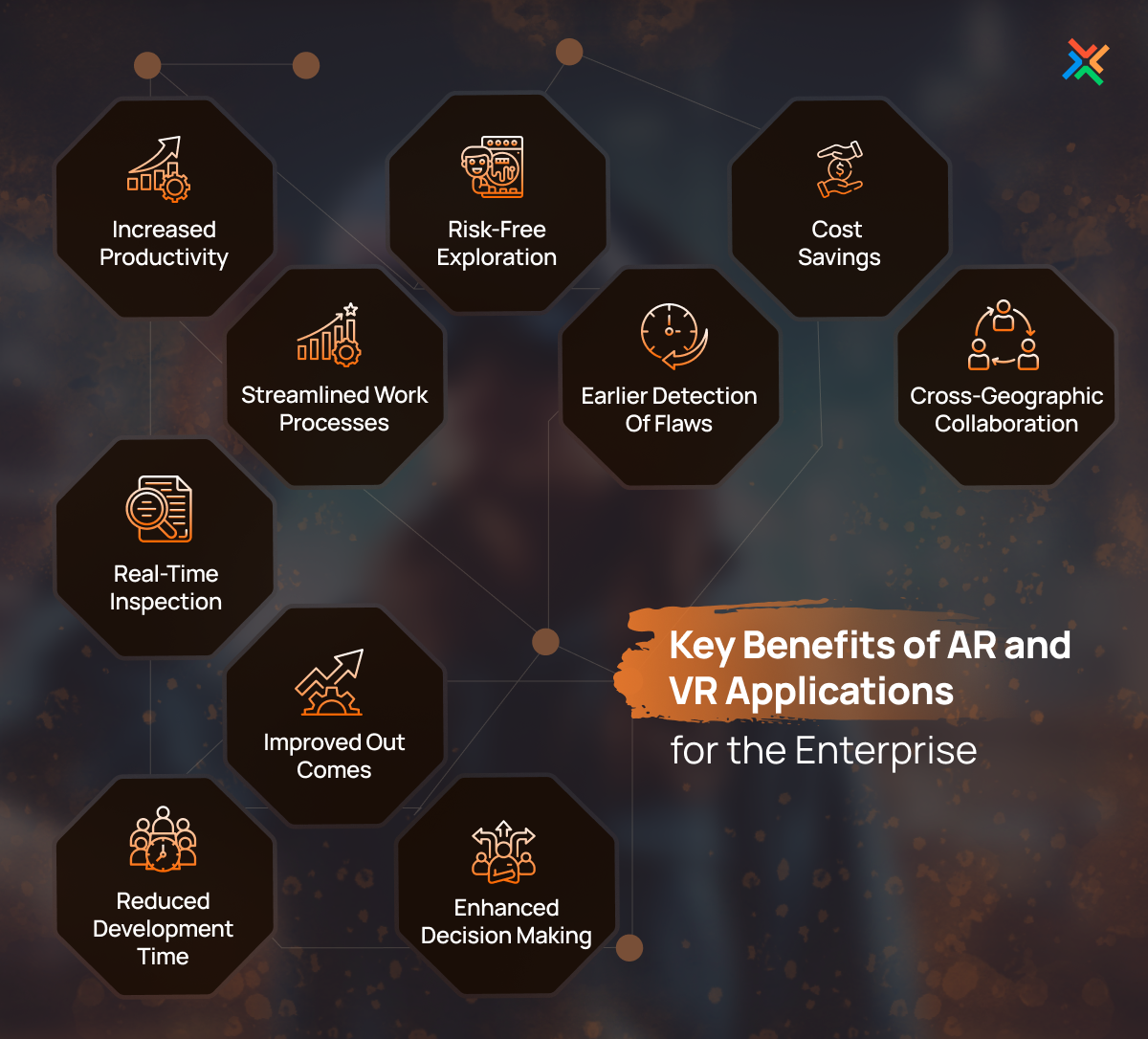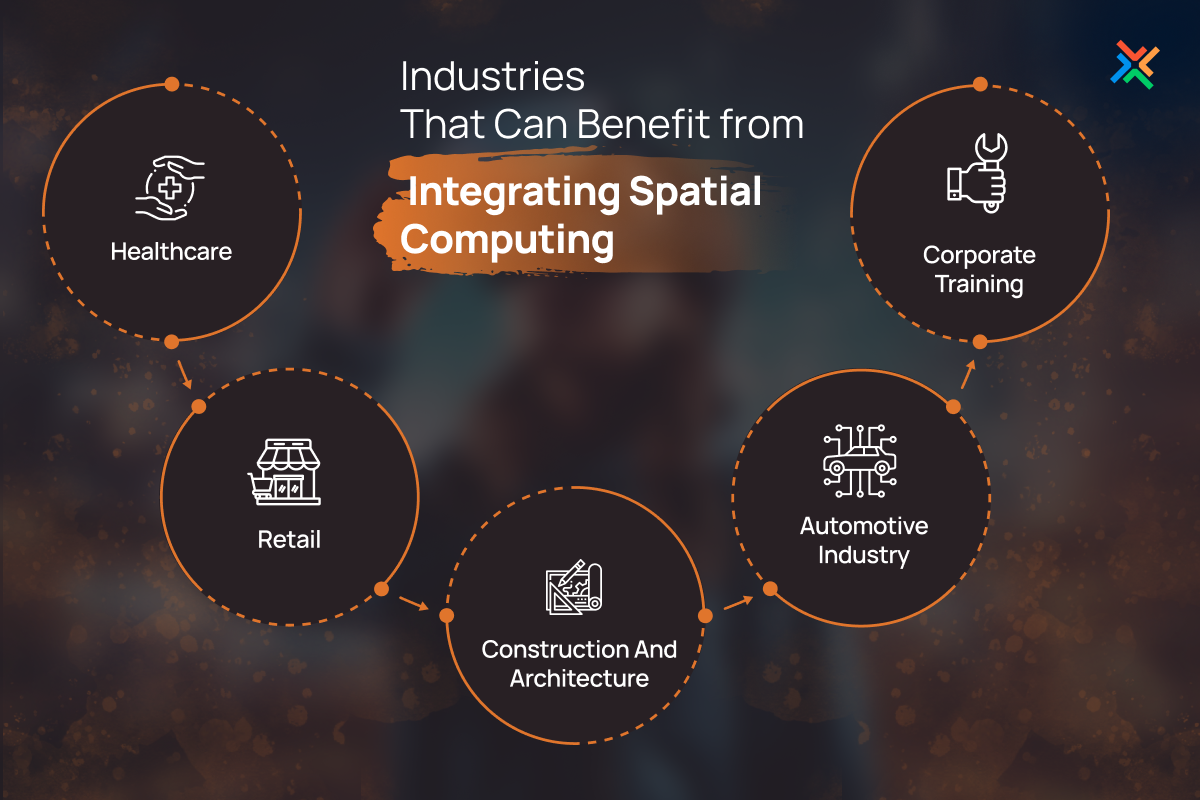The Rise of the Spatial Web: How Businesses Can Leverage AR and VR for Enhanced User Experiences
July 08, 2024

Vivek Adatia
.png?w=1920&q=75)
The way we interact with the world is undergoing a substantial transformation. Just a decade ago, the concept of blending physical and digital experiences seemed far-fetched. Today, advancements in Augmented Reality (AR) and Virtual Reality (VR) technologies are blurring the lines between our realities. This leads us to the concept of the Spatial Web.
Understanding Spatial Web
You can think of the Spatial Web as the next iteration of the Internet, advancing beyond the traditional flat web pages we’re accustomed to. It represents an efficient integration of the physical and digital worlds, creating a 3D environment where users can interact with information and each other in a more intuitive and immersive way. The Spatial Web utilizes AR, VR, and Mixed Reality (MR) to provide users with 3D interfaces and persistent experiences that can be accessed across various devices. This shift from the traditional 2D web to a more immersive and interactive environment is set to transform how businesses engage with their customers and employees.

The Rise of AR and VR
AR and VR technologies have come a long way since their early days. Once considered niche and expensive, these technologies are now more accessible and user-friendly than ever before. The global AR and VR market is expected to grow from $32.1 billion in 2024 to $58.1 billion by 2028, a testament to their increasing adoption and popularity. Advancements in hardware, such as lightweight and comfortable headsets, and software, including more intuitive and engaging experiences, have made AR and VR more appealing to a wider audience.
Why Businesses Should Adopt Spatial Web
The Spatial Web offers an exciting opportunity for businesses to enhance user experiences, boost customer engagement, and drive innovation across multiple industries. From virtual product trials in retail to improved training simulations in manufacturing, businesses can innovate and differentiate themselves in their respective industries in various ways utilizing the spatial web.
Moreover, the spatial web can help businesses optimize operations, improve collaboration, and enhance decision-making processes within organizations. By providing employees with access to real-time data and virtual tools, businesses can increase productivity and efficiency, leading to a more collaborative and innovative work environment.

How Businesses Can Utilize AR & VR for Improved User Experiences
The Spatial Web thrives on the combined strengths of AR/VR development services in the UAE, each offering unique capabilities to revolutionize user experiences. From product visualization to remote collaboration, these innovative technologies offer a wide range of applications that can help businesses stand out in a competitive environment.
AR Use Cases
Product Visualization and Try-Before-You-Buy Experiences
One of the most prominent use cases for AR in businesses is the ability to virtually place products in a user’s environment. This allows customers to see how a product would look and fit in their space before making a purchase, reducing the likelihood of returns and increasing customer satisfaction. AR can be particularly useful for industries such as furniture, home décor, and beauty, where visualizing the product is crucial to the buying decision.
Improved Maintenance & Repair
AR can also be utilized to provide step-by-step instructions with 3D overlays for maintenance tasks or product repairs. By superimposing digital information onto the physical world, AR can guide technicians through complex procedures, reducing errors and improving efficiency. This use case becomes especially relevant in industries such as manufacturing, where proper maintenance is critical to maintaining standard product quality and longevity.
Interactive Training and Education
AR injects a layer of interactivity into traditional training methods. This immersive approach improves knowledge retention and engagement. By incorporating interactive elements and 3D visualizations, AR can make learning more engaging and effective, particularly for complex topics or hands-on skills. Furthermore, AR can be used in educational settings to bring complex concepts to life. Students can explore 3D models of historical landmarks, dissect virtual frogs in biology class, or visualize the solar system on a real-world scale – all through the lens of their smartphones or tablets.
VR Use Cases
Virtual Showrooms and Product Demonstrations
VR can create virtual showrooms where customers can explore products in a realistic 3D environment. For instance, suppose a customer explores a car dealership virtually by utilizing VR. They can examine every detail of a car model, experience the interiors in 360 degrees, and even take a simulated test drive. This allows businesses to showcase their offerings in a more engaging and interactive way, without the limitations of physical space. VR showrooms can be particularly beneficial for high-value products or those with complex functionalities, allowing customers to explore them in detail without geographical limitations.
Remote Collaboration and Design
VR can allow teams to collaborate on projects virtually in a shared 3D space, regardless of physical location. This can be especially beneficial for industries such as architecture engineering and product design, where collaboration is essential to the creative process. By allowing team members to work together in a virtual environment, VR can reduce the need for travel and in-person meetings, improving efficiency and reducing costs.
Immersive Marketing and Storytelling
VR can be used to create interactive marketing campaigns or immersive brand experiences that leave a lasting impression. By transporting users to a virtual world that aligns with the brand’s values and messaging, VR can create a powerful emotional connection that traditional marketing channels may find difficult to achieve. This use case is applicable across various industries, from entertainment to tourism where creating a memorable experience is key to building brand loyalty and attracting new customers.

Technical Considerations and Development Tools
As businesses adopt the spatial web, it is crucial to consider the technical aspects of developing immersive experiences. From creating engaging 3D content to facilitating cross-platform compatibility, numerous factors must be taken into account to deliver effective AR and VR solutions in the UAE.
Building for the Spatial Web
Developing AR/VR experiences for the spatial web requires a deep understanding of the underlying technologies and principles. One of the key considerations is the creation of high-quality 3D content that can be efficiently integrated into the user's environment. This involves modeling, texturing, and animating 3D assets that adhere to specific technical requirements, such as polygon count, texture resolution, and lighting conditions.
Another important aspect is the implementation of intuitive user interaction methods. AR/VR experiences should utilize natural user interfaces (NUI) that allow users to interact with virtual objects using gestures, voice commands, or gaze-based interactions. Designing these interactions requires careful consideration of ergonomics, user comfort, and accessibility.
Cross-platform compatibility is also a crucial factor when building for the spatial web. AR/VR experiences should be designed to work across a wide range of devices, from smartphones and tablets to dedicated AR/VR headsets. This necessitates optimizing performance, maintaining consistent visual quality, and adapting the user interface to different screen sizes and input methods.
Development Tools and Resources
Several effective development tools and frameworks are available for simplifying the process of creating AR/VR experiences for the spatial web.
- Unity: A comprehensive game engine and development platform that supports the creation of AR/VR experiences for a wide range of platforms, including iOS, Android, and various VR headsets.
- Unreal Engine: A powerful game engine known for its high-quality graphics and real-time rendering capabilities. Unreal Engine is particularly well-suited for developing immersive VR experiences.
- ARKit: Apple's framework for building AR experiences on iOS devices, utilizing advanced computer vision and machine learning algorithms to offer realistic object placement and interaction.
- ARCore: Google's platform for building AR experiences on Android devices, offering similar capabilities to ARKit in terms of environmental understanding and object interaction.
- WebXR: This emerging web API offers a standardized way to develop immersive web experiences accessible through standard web browsers. WebXR allows developers to create AR/VR experiences that can be accessed on any device with a compatible browser, lowering the barrier to entry for the Spatial Web.
Security and Privacy Considerations
When developing AR/VR experiences for the spatial web, it is crucial to prioritize security and privacy. AR/VR applications often collect and process sensitive user data, such as location information, spatial maps, and personal preferences. Making sure that this data is securely stored and transmitted is essential to maintaining user trust and complying with relevant regulations.
Developers should implement efficient encryption protocols, secure authentication methods, and clear privacy policies to protect user data. Furthermore, they should be transparent about the data collection practices and provide users with control over their personal information, such as the ability to opt out of data sharing or request data deletion.
By addressing these technical considerations and utilizing the right development tools and resources, businesses can create engaging and effective AR/VR experiences for the spatial web. However, it is important to remember that the field of spatial computing is advancing fast, and staying up-to-date with the latest trends and best practices is vital for success.
The Future of the Spatial Web
Various emerging trends are set to shape the future trajectory of the spatial web. One of the most important developments is the increasing integration of artificial intelligence (AI) into spatial computing applications. AI algorithms can improve the user experience by providing more intelligent and contextual information, facilitating personalized recommendations, and hassle-free interactions. Furthermore, AI can be utilized for spatial data analysis, allowing businesses to gain valuable insights from the huge amount of data generated by AR/VR applications.
Another notable trend is the advent of the metaverse – a shared virtual space where users can interact, work, and play in a persistent, interconnected environment. With ongoing advancements in the metaverse, it will likely become more immersive and realistic, with the integration of advanced haptic technologies that provide a sense of touch and physical feedback. This convergence of the physical and digital worlds will open up new possibilities for collaboration, entertainment, and commerce, reinventing how we perceive and interact with the world around us.
The Spatial Web presents both challenges and opportunities for businesses across diverse industries. Early adopters who harness these technologies effectively can gain a significant competitive advantage.
Businesses can prepare for this shift – first, by analyzing their industry and identifying areas where AR/VR experiences can improve customer interactions, optimize internal processes, or enhance training initiatives. Secondly, they ought to invest in developing in-house expertise in AR/VR development or partner with an experienced AR/VR app development company in the UAE to build impactful spatial web experiences. Finally, businesses need to start considering small-scale AR/VR pilot projects to test the waters and gain valuable insights for future applications.
So if you’re looking to explore the possibilities around the spatial web and AR/VR solutions, at WDCS Technology, we can help! Schedule a free consultation with our AR/VR experts today to discuss how we can work together to create groundbreaking AR/VR experiences.
Tap into Spatial Web with AR/VR solutions from WDCS Technology
Spatial computing is the bridge between the physical and digital. WDCS Technology provides innovative AR/VR solutions to transform your customer experience. Let's connect!